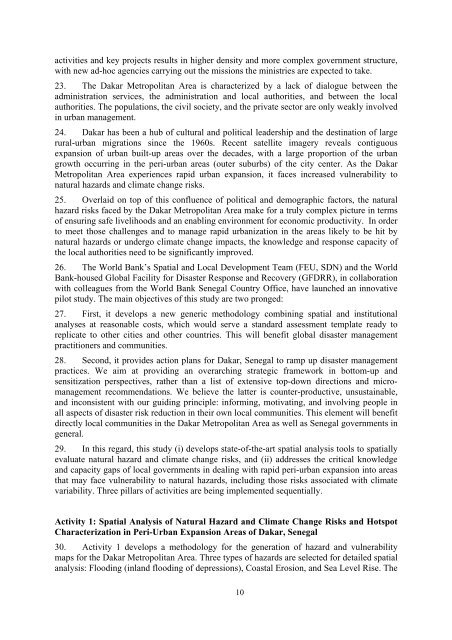natural Hazards and Climate Change risks - GFDRR
natural Hazards and Climate Change risks - GFDRR
natural Hazards and Climate Change risks - GFDRR
You also want an ePaper? Increase the reach of your titles
YUMPU automatically turns print PDFs into web optimized ePapers that Google loves.
activities <strong>and</strong> key projects results in higher density <strong>and</strong> more complex government structure,<br />
with new ad-hoc agencies carrying out the missions the ministries are expected to take.<br />
23. The Dakar Metropolitan Area is characterized by a lack of dialogue between the<br />
administration services, the administration <strong>and</strong> local authorities, <strong>and</strong> between the local<br />
authorities. The populations, the civil society, <strong>and</strong> the private sector are only weakly involved<br />
in urban management.<br />
24. Dakar has been a hub of cultural <strong>and</strong> political leadership <strong>and</strong> the destination of large<br />
rural-urban migrations since the 1960s. Recent satellite imagery reveals contiguous<br />
expansion of urban built-up areas over the decades, with a large proportion of the urban<br />
growth occurring in the peri-urban areas (outer suburbs) of the city center. As the Dakar<br />
Metropolitan Area experiences rapid urban expansion, it faces increased vulnerability to<br />
<strong>natural</strong> hazards <strong>and</strong> climate change <strong>risks</strong>.<br />
25. Overlaid on top of this confluence of political <strong>and</strong> demographic factors, the <strong>natural</strong><br />
hazard <strong>risks</strong> faced by the Dakar Metropolitan Area make for a truly complex picture in terms<br />
of ensuring safe livelihoods <strong>and</strong> an enabling environment for economic productivity. In order<br />
to meet those challenges <strong>and</strong> to manage rapid urbanization in the areas likely to be hit by<br />
<strong>natural</strong> hazards or undergo climate change impacts, the knowledge <strong>and</strong> response capacity of<br />
the local authorities need to be significantly improved.<br />
26. The World Bank’s Spatial <strong>and</strong> Local Development Team (FEU, SDN) <strong>and</strong> the World<br />
Bank-housed Global Facility for Disaster Response <strong>and</strong> Recovery (<strong>GFDRR</strong>), in collaboration<br />
with colleagues from the World Bank Senegal Country Office, have launched an innovative<br />
pilot study. The main objectives of this study are two pronged:<br />
27. First, it develops a new generic methodology combining spatial <strong>and</strong> institutional<br />
analyses at reasonable costs, which would serve a st<strong>and</strong>ard assessment template ready to<br />
replicate to other cities <strong>and</strong> other countries. This will benefit global disaster management<br />
practitioners <strong>and</strong> communities.<br />
28. Second, it provides action plans for Dakar, Senegal to ramp up disaster management<br />
practices. We aim at providing an overarching strategic framework in bottom-up <strong>and</strong><br />
sensitization perspectives, rather than a list of extensive top-down directions <strong>and</strong> micromanagement<br />
recommendations. We believe the latter is counter-productive, unsustainable,<br />
<strong>and</strong> inconsistent with our guiding principle: informing, motivating, <strong>and</strong> involving people in<br />
all aspects of disaster risk reduction in their own local communities. This element will benefit<br />
directly local communities in the Dakar Metropolitan Area as well as Senegal governments in<br />
general.<br />
29. In this regard, this study (i) develops state-of-the-art spatial analysis tools to spatially<br />
evaluate <strong>natural</strong> hazard <strong>and</strong> climate change <strong>risks</strong>, <strong>and</strong> (ii) addresses the critical knowledge<br />
<strong>and</strong> capacity gaps of local governments in dealing with rapid peri-urban expansion into areas<br />
that may face vulnerability to <strong>natural</strong> hazards, including those <strong>risks</strong> associated with climate<br />
variability. Three pillars of activities are being implemented sequentially.<br />
Activity 1: Spatial Analysis of Natural Hazard <strong>and</strong> <strong>Climate</strong> <strong>Change</strong> Risks <strong>and</strong> Hotspot<br />
Characterization in Peri-Urban Expansion Areas of Dakar, Senegal<br />
30. Activity 1 develops a methodology for the generation of hazard <strong>and</strong> vulnerability<br />
maps for the Dakar Metropolitan Area. Three types of hazards are selected for detailed spatial<br />
analysis: Flooding (inl<strong>and</strong> flooding of depressions), Coastal Erosion, <strong>and</strong> Sea Level Rise. The<br />
10

















